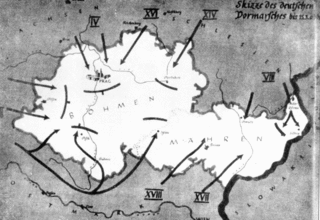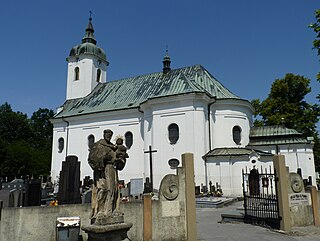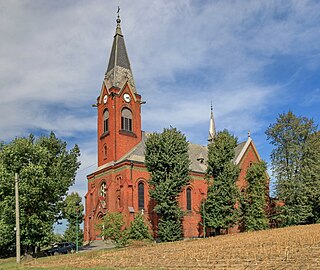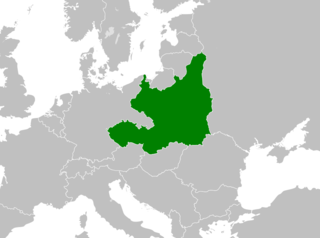
The Munich Agreement was an agreement concluded at Munich on 30 September 1938, by Nazi Germany, the United Kingdom, France, and Italy. The agreement provided for the German annexation of land on the border between Czechoslovakia and Germany called the Sudetenland, where more than three million people, mainly ethnic Germans, lived. The pact is also known in some areas as the Munich Betrayal, because of a previous 1924 alliance agreement and a 1925 military pact between France and the Czechoslovak Republic.

The military occupation of Czechoslovakia by Nazi Germany began with the German annexation of the Sudetenland in 1938, continued with the creation of the Protectorate of Bohemia and Moravia, and by the end of 1944 extended to all parts of Czechoslovakia.
The mass media in Communist Czechoslovakia was controlled by the Communist Party of Czechoslovakia (KSČ). Private ownership of any publication or agency of the mass media was generally forbidden, although churches and other organizations published small periodicals and newspapers. Even with this informational monopoly in the hands of organizations under KSČ control, all publications were reviewed by the government's Office for Press and Information. Censorship was lifted for three months during the 1968 Prague Spring but afterward was reimposed under the terms of the 1966 Press Law. The law states that the Czechoslovak press is to provide complete information, but it must also advance the interests of socialist society and promote the people's socialist awareness of the policy of the communist party as the leading force in society and state.
Trans-Olza, also known as Trans-Olza Silesia, is a territory in the Czech Republic, which was disputed between Poland and Czechoslovakia during the Interwar Period. Its name comes from the Olza River.

Ludvík Svoboda was a Czech general and politician. He fought in both World Wars, for which he was regarded as a national hero, and he later served as the president of Czechoslovakia from 1968 to 1975.

Cieszyn Silesia, Těšín Silesia or Teschen Silesia is a historical region in south-eastern Silesia, centered on the towns of Cieszyn and Český Těšín and bisected by the Olza River. Since 1920 it has been divided between Poland and Czechoslovakia, and later the Czech Republic. It covers an area of about 2,280 square kilometres (880 sq mi) and has about 810,000 inhabitants, of which 1,002 square kilometres (387 sq mi) (44%) is in Poland, while 1,280 square kilometres (494 sq mi) (56%) is in the Czech Republic.

Návsí (help·info) is a municipality and village in Frýdek-Místek District in the Moravian-Silesian Region of the Czech Republic. It has about 3,800 inhabitants. The municipality has a significant Polish minority.

Dolní Lutyně (help·info) is a municipality and village in Karviná District in the Moravian-Silesian Region of the Czech Republic. It has about 5,200 inhabitants.

Dětmarovice is a municipality and village in Karviná District in the Moravian-Silesian Region of the Czech Republic. It has about 4,300 inhabitants.

Albrechtice is a municipality and village in the Karviná District in the Moravian-Silesian Region of the Czech Republic. It has about 3,800 inhabitants. The municipality has a significant Polish minority.

Stonava is a municipality and village in Karviná District in the Moravian-Silesian Region of the Czech Republic. It has about 1,800 inhabitants. The municipality has a significant Polish minority.

Doubrava (help·info) is a municipality and village in Karviná District in the Moravian-Silesian Region of the Czech Republic. It has about 1,200 inhabitants.

Vělopolí (help·info) is a municipality and village in Frýdek-Místek District in the Moravian-Silesian Region of the Czech Republic. It has about 300 inhabitants. The municipality has a significant Polish minority.

Rudnik is a village in Gmina Hażlach, Cieszyn County, Silesian Voivodeship, southern Poland. It has a population of 479 (2017).

Łączka is a village in Gmina Dębowiec, Cieszyn County, Silesian Voivodeship, southern Poland. It has a population of 288 (2004).

The Republic of Poland and Czechoslovakia established relations early in the interwar period, after both countries gained independence. Those relations were somewhat strained by the Polish–Czechoslovak border conflicts over Zaolzie and Cieszyn in the early 1920s and late 1930s. Both countries joined the Allies during World War II. After the war they both fell into the Soviet sphere of influence. Poland, together with other Eastern Bloc countries, participated in the Warsaw Pact invasion of Czechoslovakia in 1968. Relations between the two countries were nonetheless rather amicable, but became somewhat strained in the aftermath of the rise of the Solidarity movement in Poland in 1980 and 1981, improving again afterwards.

Emanuel Chobot was a Polish trade union activist and politician from the region of Zaolzie, Czechoslovakia. He was the chairman of the Polish Socialist Workers Party, the social democratic party active amongst the Polish minority in interbellum Czechoslovakia. He was also the Director-General of the Consumers Association 'Gec' in Moravská Ostrava.

Karol Śliwka was a Polish communist politician from Zaolzie region in the First Czechoslovak Republic. Śliwka was one of the most prominent political leaders of the Polish minority in Zaolzie and a member of National Assembly of the Czechoslovak Republic from 1925 to 1938.
The Silesian People’s Party was a political organization in Cieszyn Silesia that existed from 1909 to 1938 in Austrian Silesia, which later became international plebiscite territory and finally part of Czechoslovakia. The party included mainly Slavic people, who saw themselves as members of a Silesian nation. The party is seen as part of the Szlonzakian movement or Silesian Separatist Movement.

The Polish–Czechoslovak confederation, or federation, was a political concept from the time of World War II, supported by the Polish government-in-exile and, to a lesser extent, the United Kingdom and the United States. It was a revitalisation of the Intermarium concept, proposing the creation of a federation based on Poland and Czechoslovakia. The project had less support in the Czechoslovak government-in-exile, which believed it did not need Polish support against the Soviet Union, and was eventually sunk by the growing Soviet dominance, as Joseph Stalin did not want a strong and independent federation in Europe that could threaten his designs for Eastern Europe.

















